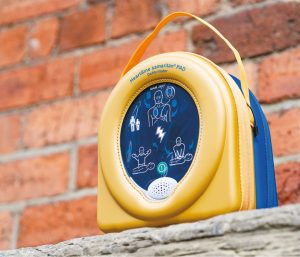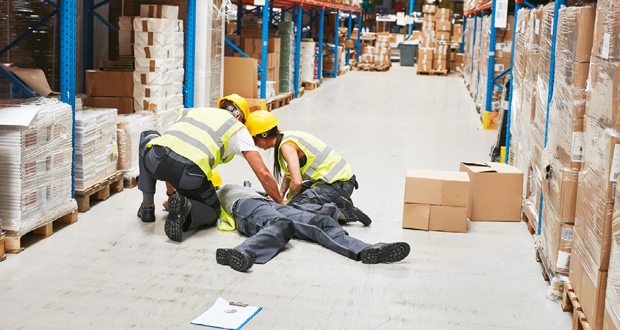 Jonathan Gilbert, Managing Director of Defib Machines explains the reasons behind the increase in demand for defibrillators and the importance of maintaining these life-saving devices
Jonathan Gilbert, Managing Director of Defib Machines explains the reasons behind the increase in demand for defibrillators and the importance of maintaining these life-saving devices
Health and safety are key considerations for FMs, whether in the provision of fire safety equipment or first aid kits. In recent years defibrillators have become an essential to that list.
Why is this? Perhaps the simple answer behind the growth in their demand has come not from the board room but the boot room or more specifically the Euro 2020 football tournament. During a group game Danish footballer Christian Eriksen collapsed on the pitch due to a cardiac event.
The harrowing scenes of this elite athlete surrounded by both his teammates and the opposition made front page news across the globe and, perhaps more than anything, highlighted the importance of early access to a defibrillator.
Since then and driven by further factors stemming from the COVID-19 pandemic including an increased focus on health and safety, installations of devices by companies and community organisations across the UK have increased. However, is just having a device enough? The simple answer is no, but it is a step in the right direction.
The rapid upswing over the last 12 to 18 months of businesses looking to provide defibrillators is fantastic news, especially considering the shocking statistic that more than 100 cardiac arrests reportedly happen each week in the workplace. Add to that statistical evidence that only eight of those people will survive – a survival rate significantly below other developed countries – and you see the scale of the issue.
But while it’s great to know that more people are improving access to these devices, it’s important to remember that access isn’t the silver bullet solution. There are a number of other key factors that FMs need to consider when getting a device.
Taking three of the major ones:
MAINTENANCE
Like any piece of life saving technology, it needs to be looked after. On average, a defibrillator will have a shelf life in the region of five to eight years. However, the device also contains perishable components, namely the batteries and pads, which typically have a two-year shelf life unless used.
This means that when you buy a device that is just the first step. Crucially, you’ve still got to know when and where to buy the perishable components, whether that’s just to maintain the device every two years or after the device has been called on for its sole purpose – to save someone’s life.
Our suggestion for the most basic maintenance procedure is that a device be checked monthly, with a simple visual inspection, ensuring there’s no signs of damage, the batteries and pads are still there and there’s no flashing lights or beeping. Many devices will, like smoke detectors, notify when batteries are running low. It may seem simple, but this check ensures two things: first, that the device should be operational, and second, that people don’t become blind to a device they’ll need to work immediately in the event of an emergency.
Alongside the monthly checks, it’s best practice once your defibrillator reaches two years old to have it professionally serviced. This will typically see a company like Defib Machines use a device that mimics various forms of heart  rhythms to ensure the defibrillator can recognise those that need a shock and those that don’t and that it can deliver the required ‘jolt’.
rhythms to ensure the defibrillator can recognise those that need a shock and those that don’t and that it can deliver the required ‘jolt’.
LOCATION
One of the most common questions I’ve been asked is where should a device be placed; does it need to go on a wall, does it need to be placed outside, do we need one on every floor?
The simple answer is there is no legal requirement to have a defibrillator or how many an office should have based on the number of people within it. We typically suggest someone should be able to get to a device within two minutes – this can differ significantly dependent on the layout of a building and access permissions.
The concept of timing might sound arbitrary, but studies show that getting access to a defibrillator within five minutes could increase survival rates 14-fold. So, two minutes to get the device two minutes back and a minute to administer the shock and you have your five-minute window, giving yourself the best chance to save a life. If a shock can be given in the first minute the chance of survival increases to 90 per cent.
Visibility and access are also extremely important factors with your defib. It’s no good having a device if no one knows about it or where to find it. Making the device easily accessible in an emergency reduces any delays on providing therapy. We work with customers to find solutions to avoid devices being locked away. Placing a device in a reception area, canteens or first aid rooms are popular central locations. In some scenarios this isn’t possible and a cabinet is needed, for example if the device is to be located outside where the device requires heat and protection from the elements. If a defib is placed in a cabinet, having a process for recovering the access code for this is essential.
We always recommend our customers add their devices to the national AED database (The Circuit). This allows for members of the public to be directed to the device during the hours it is available, by the ambulance service in the event of a cardiac emergency. If the device is in a cabinet this will make it available 24/7 and the ambulance service will keep a record of the access code.
Ultimately wherever a device is located, signage directing people to it is essential! Don’t be afraid of reminding people about the device regularly, this may help them remember about it during an emergency.
EDUCATION
Understanding your device and having people onsite who know how to use it is key to having a successful AED program. Most providers of AED’s will provide free training when the device is installed, whilst service providers include training sessions as part of the maintenance package.
It is always a good idea to have as many people on site trained as it can reduce any anxieties or misconceptions about using the device. As an AED can be used by anyone you do not have to be first aid trained to learn how to use one.
Education around caring for your defibrillator is also important. Devices can sometimes be sold under the guidance that they will look after themselves which sadly is not true. These are professional pieces of life saving equipment and should be cared for in that way.
As mentioned earlier, AEDs as a minimum should be provided with a visual check every month and best practice is to have the device professionally cared for every two years. It should also be noted that the average recommended shelf life of an AED is five to eight years.
Devices also require their pads and batteries to be changed between every two and four years dependent on model. Currently the lead times can be up to nine months on these consumables so be wary of this and plan ahead.
Finally understand the processes required if a device is used. Pads and batteries will require changing and a service should be conducted. There is also data on the device which is useful to the manufacturers and may be of use to the NHS, so this should be recovered where possible.
A fully serviced and maintained package provides these three pillars and is designed to make a working AED accessible and affordable in the workplace. If you manage multiple sites nationwide this provides the easiest way to have a consistent and reliable program in place across all locations.





